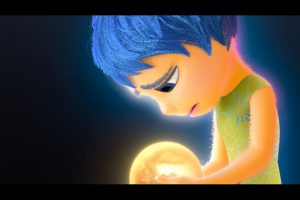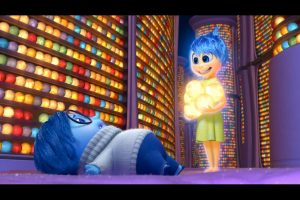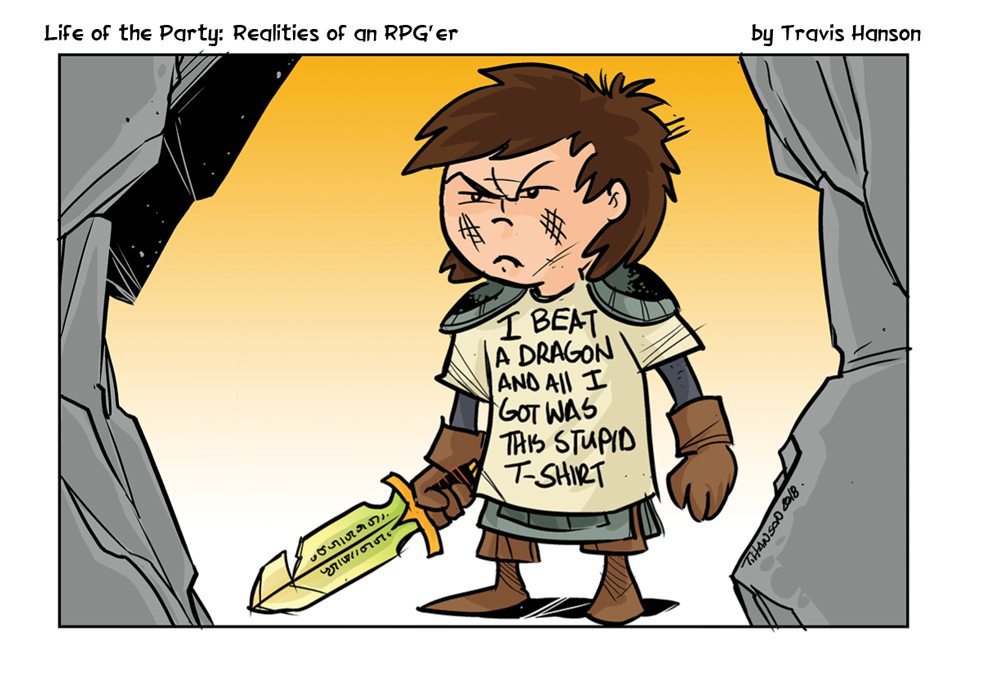Previous Pixar films have taken us to the bottom of the ocean, the dead Earth of the distant future, Medieval Scotland, the world of monsters in the closet, the wilds of South America and a little boy’s toybox, but Inside Out, their deepest and most complex film ever, explores a world never seen before.The film begins with the birth of a girl named Riley and shows us her life as she becomes a funny, goofy, adventurous and above all, happy girl of 11 years. But Riley is not the main character or even the hero of the film; she’s the setting. The film takes place inside her brain, and the stars are her emotions.
Inside Out is narrated by Riley’s first and most primary emotion, Joy (Amy Poehler), who leads the other emotions in taking care of Riley’s needs. Fear (Bill Hader) keeps her safe, Disgust (Mindy Kaling) keeps her from being poisoned, Anger (Lewis Black) makes sure Riley is treated fairly, and Sadness (Phyllis Smith), well, Sadness makes Riley feel sad, and Joy really doesn’t like that and doesn’t understand it.

1. What is it about?
Riley’s life has turned upside-down; her family is moving from Minnesota to San Francisco, and the formerly popular captain of the hockey team is now the awkward new kid with no friends. Meanwhile, Sadness keeps touching Riley’s favorite memories and making them sad, leading to a conflict with Joy that results in both of them accidentally getting sucked into the machinery that sends memories to the long-term storage area. While Joy and Sadness try to find their way back to Headquarters to restore her core memories, Fear, Anger and Disgust try to cover for them. They aren’t able to put on a convincing display, which results in a very moody Riley who lashes out at her parents, cries at school, and ultimately decides to run away and go back to Minnesota. Each reaction and decision further destroys parts of her personality and makes it harder for Joy and Sadness to return. Along the way, Joy comes to understand what Sadness does and why she’s important to Riley’s well-being.
2. Will I like it?
Judging by the 99% positive reviews on Rotten Tomatoes, I’d say it’s a pretty safe bet that you will. (That 1% guy seems to have wanted to give a bad review solely to bring down what had been a 100% positive rating.) Like director Pete Docter’s previous film, Up, this one is as much for adults as children. But then, Pixar doesn’t make children’s movies; they make movies for all ages.

3. Will my kids like it?
The ones in the theater when I saw it loved it, though they responded to different things than I did. The characters are funny and engaging, Riley’s struggles are dramatic, and kids will find themselves relating to her and maybe even beginning to understand their own emotions more. The best illustration I can give you is this: as the end credits ran, the little girl behind me said “that was SAD!” and her father immediately responded “That was GREAT!”
3. When is a good time for a bathroom break?
Like all Pixar films, Inside Out isn’t exceptionally long, clocking in at just over an hour and a half. Usually, the best bathroom break is during the “training montage set to a peppy pop song” sequence, but Inside Out doesn’t have one of those. The best opportunity is about 35 minutes in, when Sadness says “We’re going to walk out of here?” You could also run out during the sequence when they go through the Abstract Thought region; there are no important plot points there, though it’s one of the funniest and most visually interesting scenes, but when ya gotta go, ya gotta go.

4. Is the rating appropriate?
Yes. Like all Pixar films, there’s no violence or inappropriate content, though some sequences might be scary or upsetting for very young viewers. Riley’s long-neglected imaginary friend, Bing Bong (voiced by Richard Kind in a wonderful performance) will break some hearts.
5. How’s the animation?
Really wonderful. Not just the whimsical environments of Riley’s mind, but also the expressive characters, both the emotions and Riley’s family. The design of Riley’s mind, from the various mental islands to the whimsical Train of Thought, the Dr. Seuss-meets-Star Trek memory-processing machinery of Headquarters, and especially the hilarious transformations of the Abstract Thought passage, are all demonstrations of Pixar’s absolute mastery of their art. This is a film that could only be done in animation.

6. How’s the accompanying short film?
Lava, like most Pixar shorts, is primarily experimental; almost all of these films are created to test new software or techniques or solve particular problems. In this case, the question at hand is scale; when your lead characters are several miles wide, how do you make them look massive and yet keep them accessible as characters? The level of detail and atmosphere shown here is impressive. I liked the song and the love theme of the film, but there is a wide range of opinion among others I know; some thought it was borderline creepy, what with the characters being an old male volcano and a fresh young female one; others just thought it was tedious and the song too long for being built entirely around a single pun, or the “everybody needs to be paired up in heteronormative couplings” a bit off-putting. For me, the idea of a lonely character finally finding somebody who loves him just felt right, and the two singers performing the soundtrack have great voices.
7. Do I need to stay to the end of the credits?
You need to stay through the first half of the credits; there’s some funny stuff in there, but nothing after the long scroll of technical credits, or if there was, I don’t remember it, so it can’t be too important.
8. Is the 3D worth it?
Yes. There are some great sequences that benefit from the depth of field and enhanced feeling of movement that good 3D provides. Pixar understands how to use 3D effectively without letting it distract from the story.
9. What about the usual Easter Eggs?
I’m sure the Pizza Planet truck and such are in there, but I didn’t really look for them; I was too involved in the story to notice background tidbits. Pixar “good luck charm” John Ratzenberger’s cameo comes toward the end Fortunately, another site went and cataloged several of them so we don’t have to. (Note, it’s spoilerific, and some of the other features on that site may not be entirely kid-friendly.)





Good article! I agree with you about the lava song. It didn’t strike me as an older volcano and a young volcano… They were both there the whole time but weren’t able to see each other until the end. As for the heteronormality or whatever, maybe the animals in the beginning were LGBT. Lol